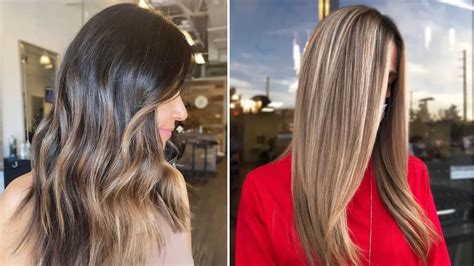When it comes to transforming your hair color, there are a bevy of dyeing techniques to choose from. Two popular methods that have gained immense popularity in the recent years are balayage and highlights. Both techniques involve lightening streaks of hair to add dimension, but they differ significantly in their application and overall effect. To help you make an informed decision that suits your unique hair goals, we present an in-depth analysis of balayage vs. highlights.

Understanding Balayage: A Sun-Kissed Effect
Balayage (pronounced “ba-lay-azh”) is a French hair dyeing technique that mimics the natural lightening effect of the sun. The process involves hand-painting bleach or lightener onto random sections of hair, creating a gradual gradient from darker roots to lighter tips. Unlike traditional highlighting, balayage is a free-form technique that does not require the use of foils or caps. This allows for a more natural and blended look, with no harsh lines or obvious demarcation between colored and uncolored hair.
Key Features of Balayage:
- Natural-looking results: Balayage creates subtle, sun-kissed highlights that seamlessly blend into your natural hair color.
- Low maintenance: The gradual gradient of color means that balayage requires less frequent touch-ups compared to traditional highlights.
- Versatile: Balayage can be customized to suit any hair type, length, and color.
Embracing Highlights: A Striking Transformation
Highlights, on the other hand, involve strategically bleaching or lightening sections of hair using foils or caps to isolate and separate them from the rest of the hair. This creates a more defined and contrasting effect, highlighting specific strands of hair against the darker background. Highlights are typically applied throughout the hair, resulting in a more dramatic and dimensional look.
Key Features of Highlights:
- Bold and eye-catching: Highlights create a striking contrast that adds depth and interest to your hair.
- Versatile placement: Highlights can be placed in various patterns and sizes to create different effects, such as face-framing or accentuating layers.
- Customization options: The width, tone, and placement of highlights can be adjusted to suit your desired look.
Balayage vs. Highlights: A Comparative Analysis
To help you determine which technique is better suited for your hair goals, we have compiled a comparative table highlighting their key differences:
| Feature | Balayage | Highlights |
|---|---|---|
| Application Method | Free-form, hand-painted | Isolated sections using foils or caps |
| Overall Effect | Natural, gradual lightening | Defined, contrasting highlights |
| Maintenance | Low maintenance, less frequent touch-ups | Higher maintenance, requires more frequent appointments |
| Versatility | Can be customized to suit any hair type and color | Suitable for most hair types, but may not blend as well with darker hair |
| Trendiness | Currently the more popular and sought-after technique | Has been popular for decades and remains a classic option |
Which Technique Is Right for You?
The choice between balayage and highlights ultimately depends on your individual preferences and hair goals.
- If you desire a natural, sun-kissed look with low maintenance, balayage is an excellent option.
- If you prefer a more defined and dramatic transformation with bolder highlights, highlights may be the better choice.
Tips and Tricks for Choosing the Right Technique
- Consult with a professional hairstylist to discuss your hair goals and determine the best technique for your individual hair type and color.
- Consider the length of your hair. Balayage tends to work better on longer hair, while highlights can be flattering on both short and long hair.
- Think about the texture of your hair. Balayage may not be as noticeable on very curly or coarse hair.
- Research different hair dye brands and formulas to find products that will provide the desired results without damaging your hair.
Pros and Cons of Balayage and Highlights
To help you make an informed decision, we present a table outlining the pros and cons of each technique:
| Technique | Pros | Cons |
|---|---|---|
| Balayage | – Natural, sun-kissed look | – May not be as noticeable on darker hair |
| – Low maintenance | – Can be more expensive than highlights | |
| – Versatile | – May take longer to apply | |
| Highlights | – Bold and eye-catching | – Higher maintenance, requires more frequent touch-ups |
| – Can create a dramatic transformation | – May damage hair more than balayage | |
| – Versatile placement options | – Can be difficult to blend with darker hair |
Additional Considerations for Making a Decision
Beyond the technical aspects, here are some additional questions to consider when choosing between balayage and highlights:
- Your budget: Balayage tends to be more expensive than highlights due to the time-consuming application process.
- Your lifestyle: Balayage requires less frequent touch-ups, making it a more convenient option for those with busy schedules.
- Your hair history: If you have previously colored or chemically treated your hair, it may be more susceptible to damage from highlighting.
- Your personal style: Consider your overall fashion sense and the look you are trying to achieve. Balayage is often associated with a more natural and bohemian style, while highlights can be more glamorous and dramatic.
Conclusion
Whether you choose the subtle, sun-kissed effect of balayage or the bolder, defined look of highlights, both techniques offer unique benefits and can transform your hair. By carefully considering the factors discussed in this article, you can make an informed decision that will enhance your natural beauty and boost your confidence.
